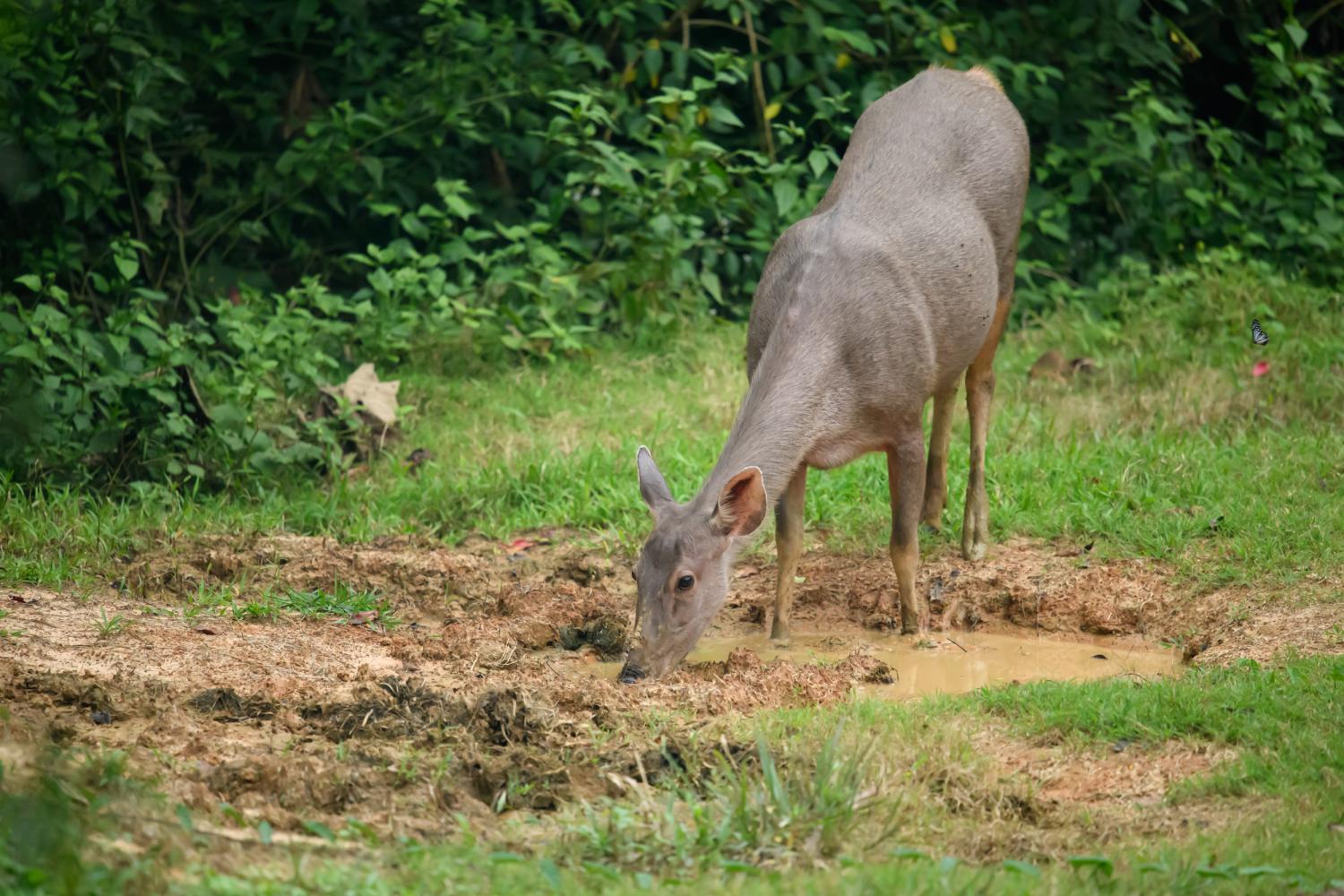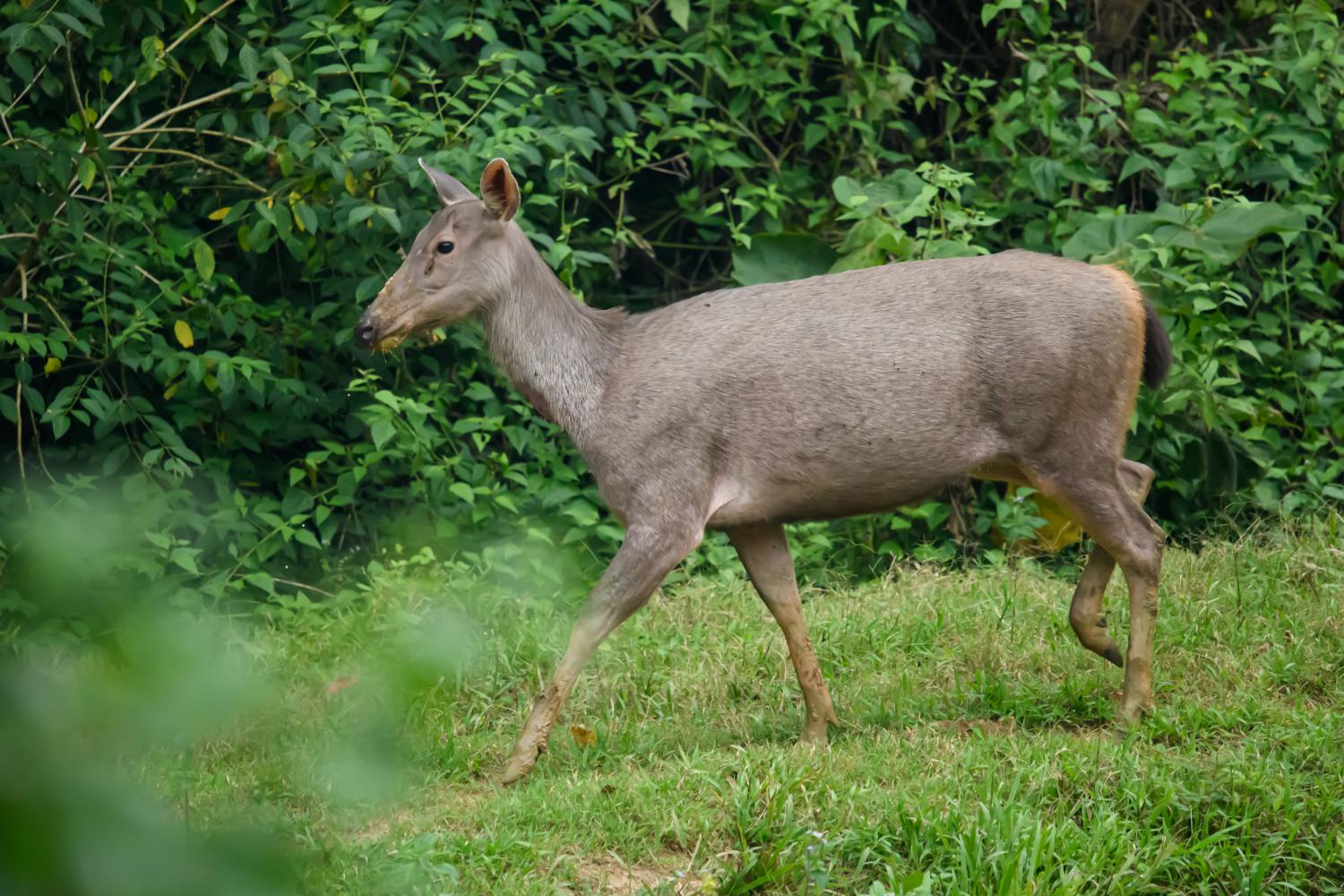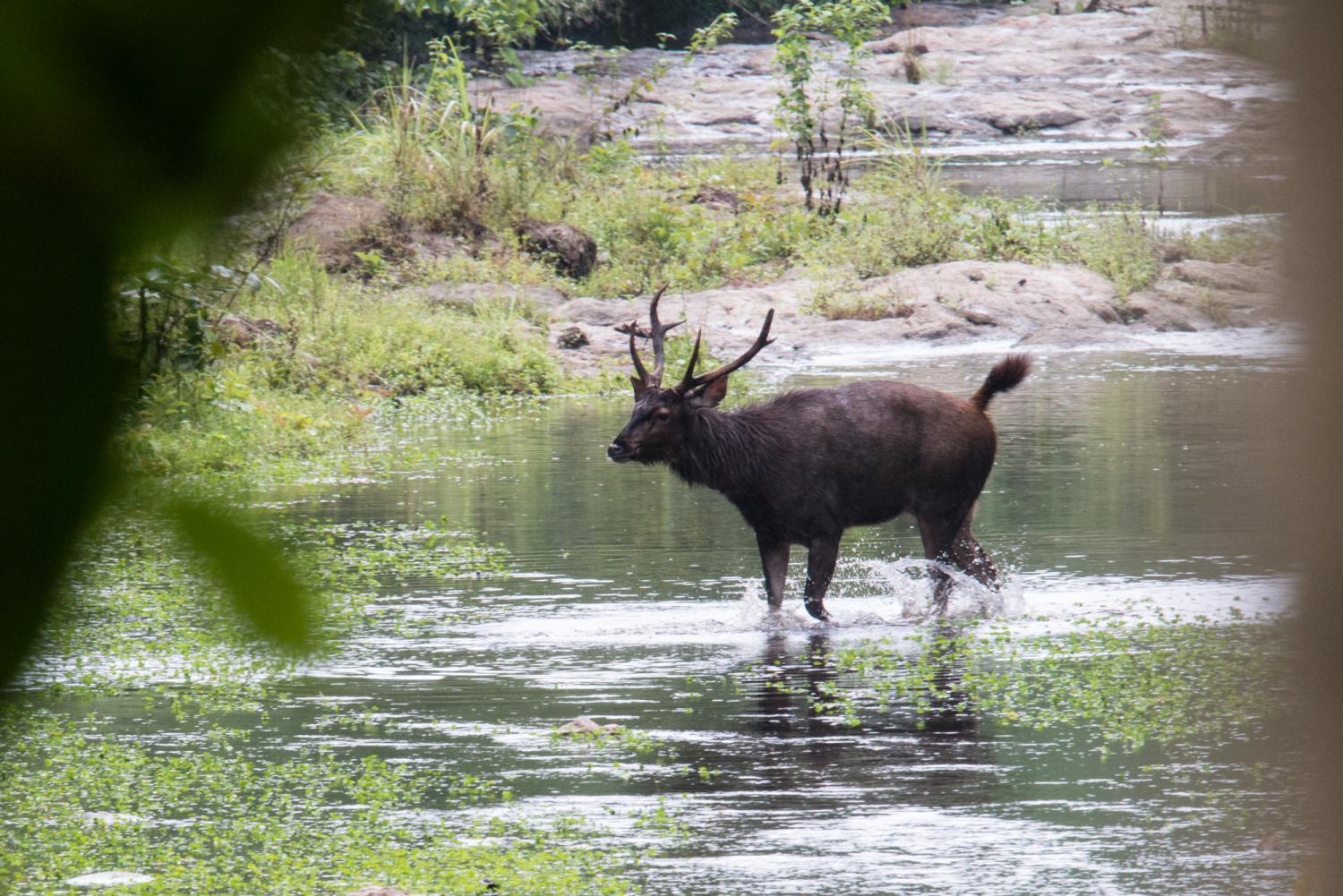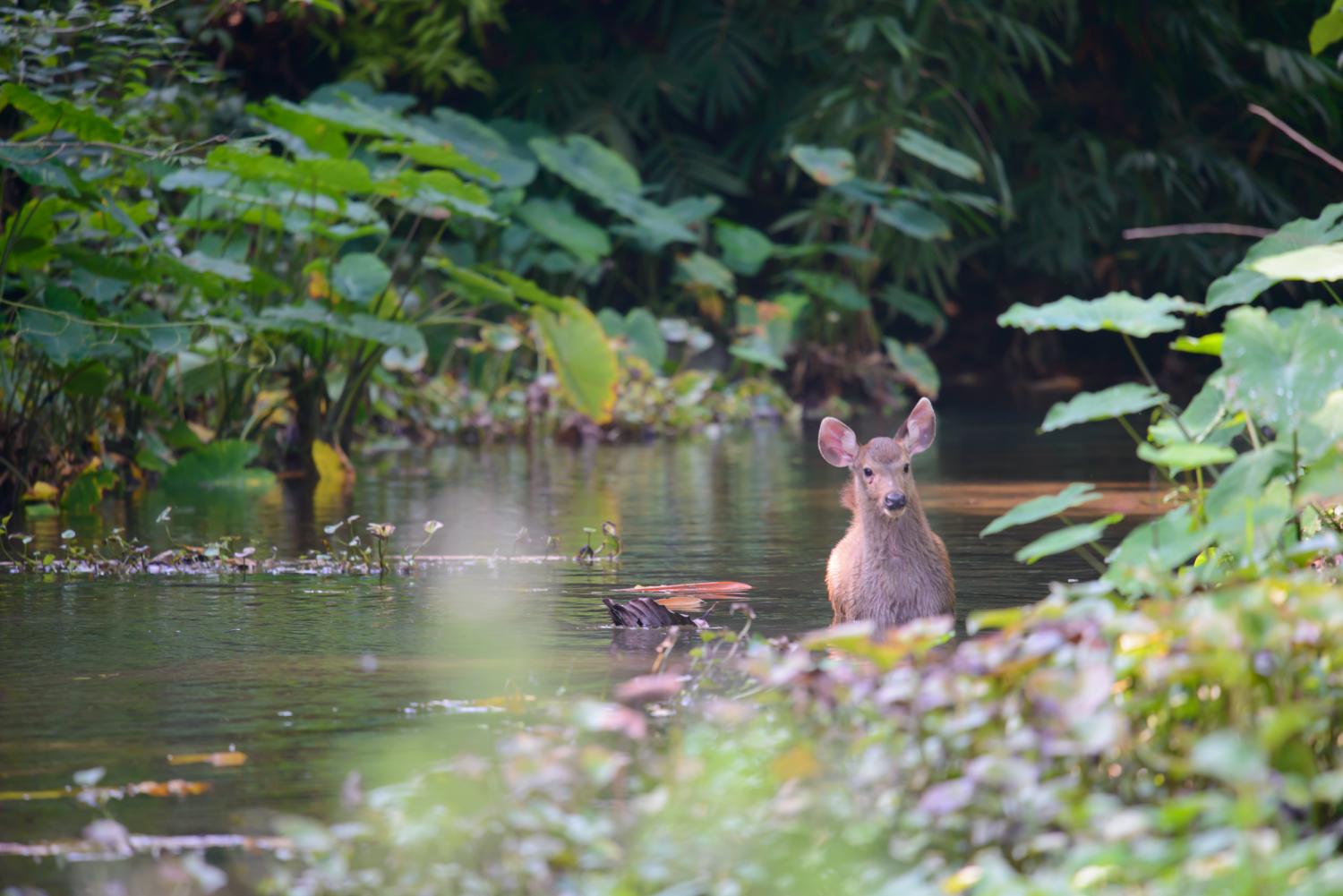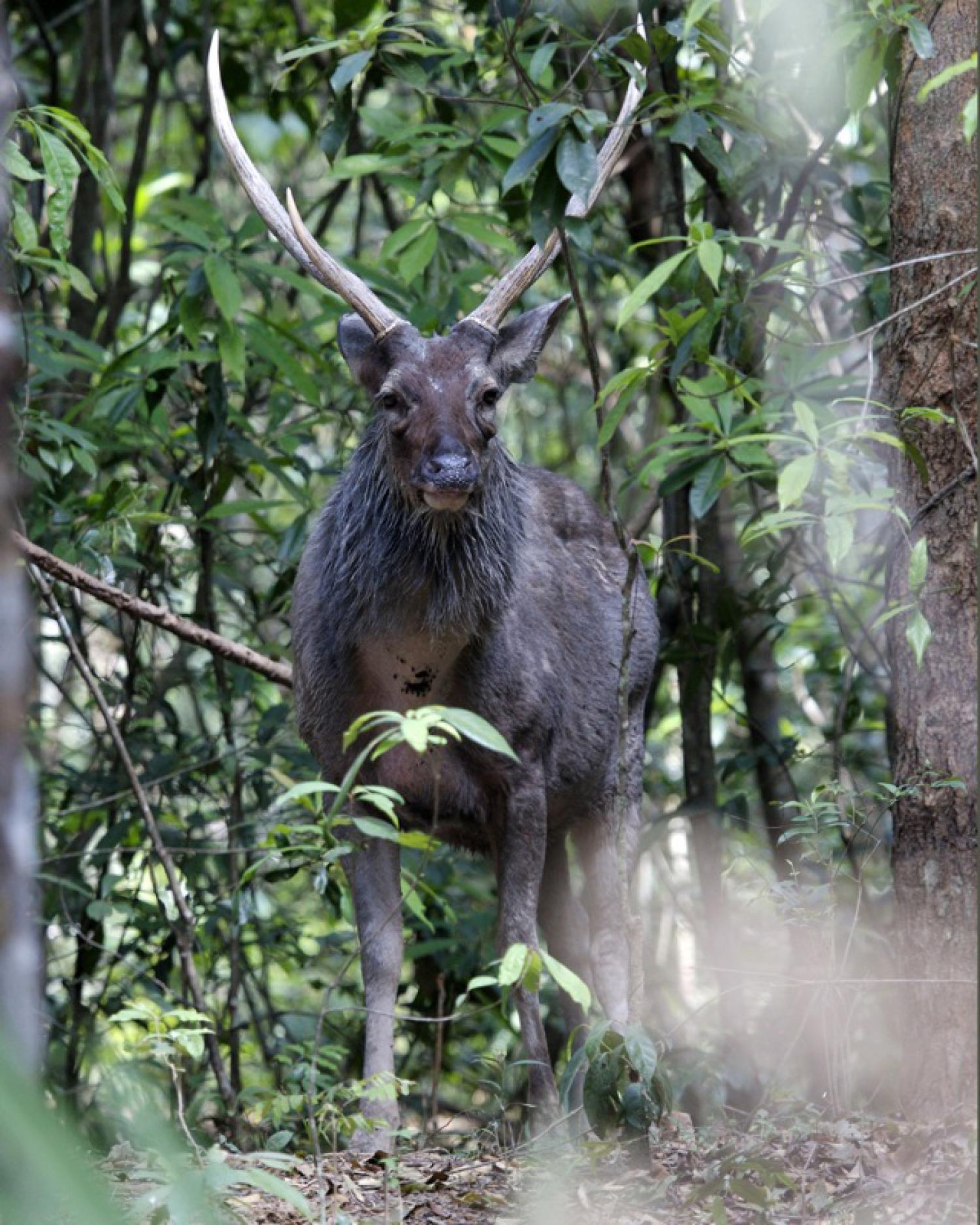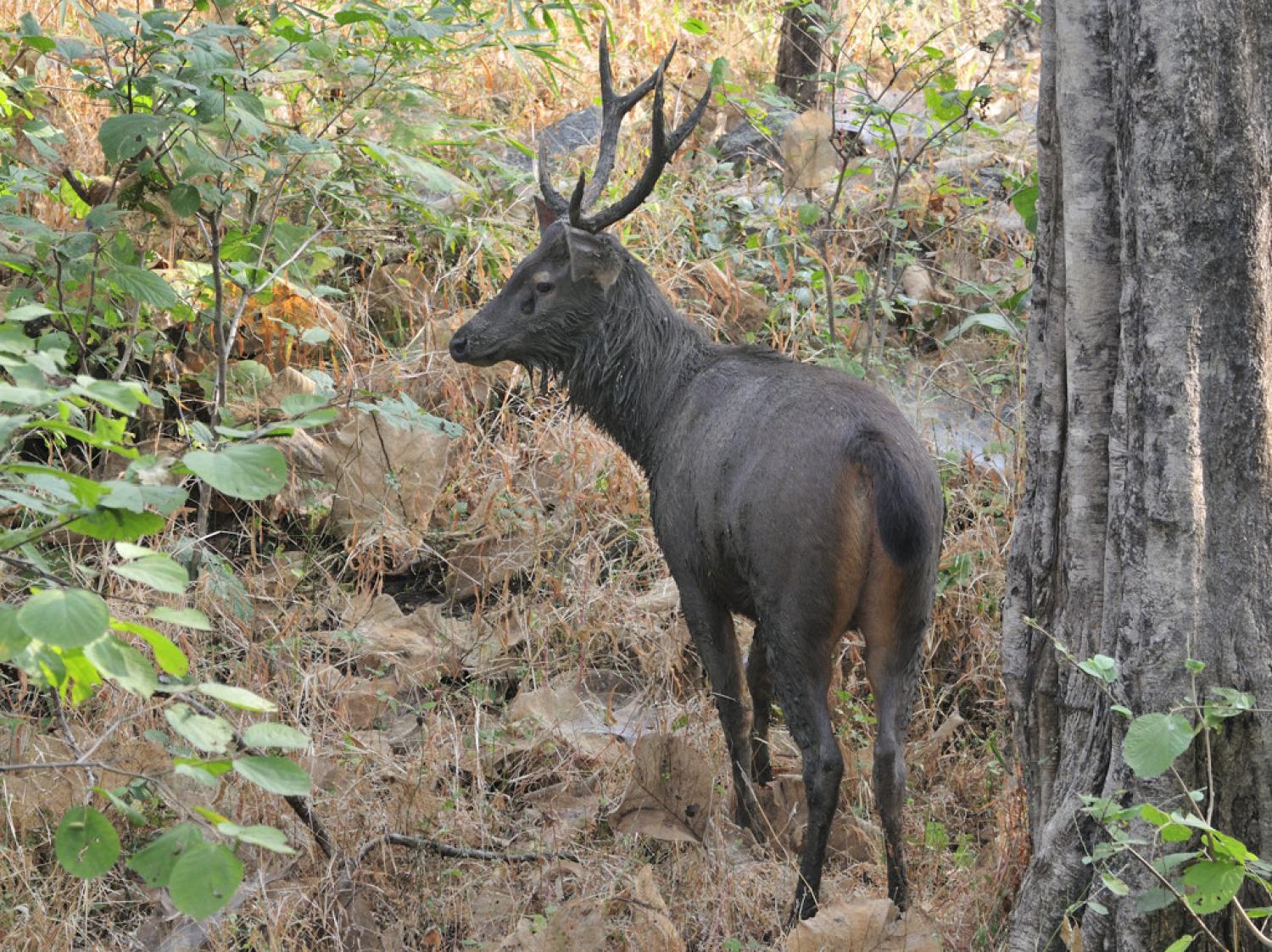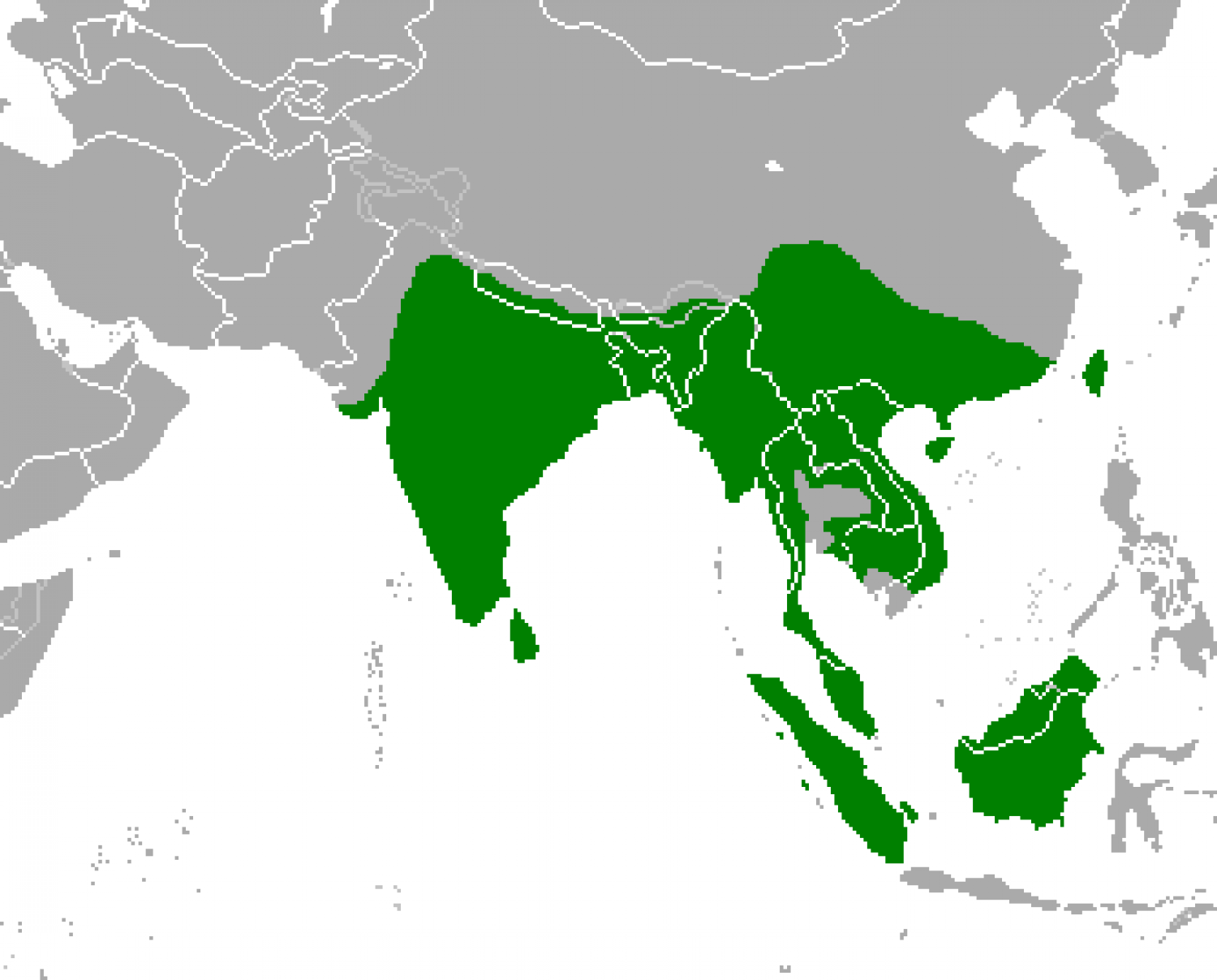Species of Thailand
Sambar deer
Rusa unicolor
(Robert Kerr, 1792)
In Thai: กวางป่า
The sambar (Rusa unicolor) is a large deer native to the Indian Subcontinent, southern China and Southeast Asia. Although it primarily refers to R. unicolor, the name "sambar" is also sometimes used to refer to the Philippine deer (called the Philippine sambar) and the rusa deer (called the Sunda sambar). The name is also spelled sambur, or sambhur.
Description
The appearance and the size of sambar vary widely across their range, which has led to considerable taxonomic confusion in the past; over forty different scientific synonyms have been used for the species. In general, they attain a height of 102 to 160 cm at the shoulder and may weigh as much as 546 kg, though more typically 100 to 350 kg. Head and body length varies from 1.62 to 2.7 m, with a 22 to 35 cm tail. Individuals belonging to western subspecies tend to be larger than those from the east and females are smaller than males. Among all living cervid species, only the moose and the elk can attain larger sizes.
The large, rugged antlers are typically rusine, the brow tines being simple and the beams forked at the tip, so that they have only three tines. The antlers are typically up to 110 cm long in fully adult individuals. As with most deer, only the males have antlers.
The shaggy coat can be anything from yellowish-brown to dark grey in colour and, while it is usually uniform in colour, some subspecies have chestnut marks on the rump and underparts. Sambar also have a small but dense mane, which tends to be more prominent in males. The tail is relatively long for deer, and is generally black above with a whitish underside.
Adult males and pregnant or lactating females possess an unusual hairless, blood-red spot located about halfway down the underside of their throats. This sometimes oozes a white liquid, and is apparently glandular in nature.
Range and ecology
The sambar inhabits much of southern Asia (as far north as the south-facing slopes of the Himalayan Mountains), mainland Southeast Asia (Burma, Thailand, Indochina, the Malay Peninsula), southern China (including Hainan Island), Taiwan, and the islands of Sumatra and Borneo.
Sambar are found in habitats ranging from tropical seasonal forests (tropical dry forests and seasonal moist evergreen forests), subtropical mixed forests (conifers, broadleaf deciduous, and broadleaf evergreen tree species) to tropical rainforests. They are seldom found far from water. They are hardy animals, ranging from sea level up to 3500 m in places such as eastern Taiwan, Myanmar, and the foothills of the Himalayan Mountains.
Sambar prefer the dense cover of deciduous shrubs and grasses, although the exact nature of this varies enormously with the environment, because of their wide range across southern Asia. Home range sizes are probably equally variable, but have been recorded as 1500 ha for males and 300 ha for females in India.
Sambar primarily live in woodland and feed on a wide variety of vegetation, including grasses, foliage, browse, fruit, and water plants, depending on the local habitat. They also consume a great variety of shrubs and trees. They are a favourite prey item for tigers and Asiatic lions. In India, the sambar can comprise up to nearly 60% of the prey selected by the Bengal tiger. Anecdotally, the tiger is said to even mimic the call of the sambar to deceive it while hunting. They also can be taken by crocodiles, mostly the sympatric mugger crocodiles and estuarine crocodiles. Leopards and dholes largely prey on only young or sickly deer, though can attack healthy adults as well.
Sambar have been seen congregating in large herds in protected areas such as national parks and reserves in India, Sri Lanka, and Thailand. In Taiwan, sambar, along with sika deer, have been raised on farms for their antlers, which they drop annually in April to May and are highly prized for use as knife handles and as grips for handguns.
Behavior and life history
Sambar are nocturnal or crepuscular. The males live alone for much of the year, and the females live in small herds of up to sixteen individuals. Indeed, in some areas, the average herd consists of only three or four individuals, typically consisting of an adult female, her most recent young, and perhaps a subordinate, immature female. This is an unusual pattern for deer, which more commonly live in larger groups. They often congregate near water, and are good swimmers. Like most deer, sambar are generally quiet, although all adults can scream or make short, high-pitched sounds when alarmed. However, they more commonly communicate by scent marking and foot stamping.
Stags will wallow and dig their antlers in urine soaked soil and then rub against tree trunks. Sambars are capable of remarkable bipedalism for a deer species and stags will stand and mark tree branches above them with their antlers. A stag will also mark himself by spraying urine directly in his own face with a highly mobile penis. Despite their lack of antlers, female sambar will readily defend their young from most predators, something that is relatively unusual among deer. When confronted by pack-hunting dholes or domestic dogs, a sambar will lower its head with an erect mane and lash at the dogs. Sambars prefer to attack predators in shallow water. Several sambars may form a defensive formation, touching rumps and vocalising loudly at the dogs. When sensing danger a sambar will stamp its feet and make a ringing call known as "pooking" or "belling".
Though they mate and reproduce year-round, sambar calving peaks seasonally. Oestrus lasts around eighteen days. The male establishes a territory from which he attracts nearby females, but he does not establish a harem. The male stomps the ground, creating a bare patch, and often wallows in the mud, perhaps to accentuate the colour of his hair, which is typically darker than that of females. While they have been heard to make a loud coarse bellow, rutting stags are generally not vocal. Large dominant stags will defend non-exclusive territories surrounded by several smaller males which they have bonded and formed alliances with through sparring. When sparring with rival males, sambar lock antlers and push, like other deer, but, uniquely, they also sometimes stand on their hind legs and clash downward into each other in a manner similar to species of goat-antelope. Females also fight on their hind legs and use their forelegs to hit each other in the head.
Courtship is based more on tending bonds rather than males vocally advertising themselves. Females moving widely among breeding territories seeking males to court. When mounting, males do not clasp females. The front legs of the male hang loosely and intromission takes the form of a "copulatory jump".
Gestation probably lasts around eight months, although some studies suggest it may be slightly longer. Normally only one calf is born at a time, although twins have been reported in up to 2% of births. Initially weighing 5 to 8 kg, the calves are usually not spotted, although in some subspecies there are light spots which disappear not long after birth. The young begin to take solid food at 5 to 14 days, and begin to ruminate after one month. Sambar have lived for up to 28 years in captivity, although it is unlikely that they often survive more than twelve years in the wild.
Taxonomy and evolution
Genetic analysis shows that the closest living relative of the sambar is probably the Javan rusa of Indonesia. This is supported by reports that sambar can still interbreed to produce fertile hybrids with this species.
Fossil sambar are known from the early Pleistocene, although it is very similar in form to early deer species from the Pliocene, with less of a resemblance to more modern cervines. The species probably arose in the tropical reaches of southern Asia, and later spread across its current range. Epirusa and Eucladoceros have both been proposed as possible ancestors of the living species and its closest relatives.
Subspecies
The subspecies of sambar in India and Sri Lanka are the largest of the genus with the largest antlers both in size and in body proportions. The South China sambar of Southern China and Mainland Southeast Asia is probably second in terms of size with slightly smaller antlers than the Indian sambar. The Sumatran sambar, that inhabits the Malay Peninsula and Sumatra, and the Bornean sambar seem to have the smallest antlers in proportion to their body size. The Formosan sambar is the smallest Rusa unicolor with antler-body proportions more similar to the South China sambar.
Currently, seven subspecies of sambar are recognised, although many others have been proposed.
| Subspecies | Common name | Geographic range |
|---|---|---|
| R. u. boninensis | Bonin sambar deer | Bonin Islands (extinct) |
| R. u. brookei | Borneo | |
| R. u. cambojensis, | Indochina and peninsular Malaysia | |
| R. u. dejeani | South China sambar Deer | Southern and southwestern China |
| R. u. equina, | Malayan sambar Deer | Sumatra |
| R. u. hainana | Hainan sambar deer | Hainan Island, China |
| R. u. swinhoii, | Formosan sambar deer | Taiwan |
| R. u. unicolor, | Sri Lankan sambar deer | India, Bangladesh, Sri Lanka |
Introduced animal
Sambar deer are an introduced species in both Australia and New Zealand, as they are in other parts of the world, such as the United States.
Australia
In Australia, hunting them is a popular sport. Australian hunting fraternities consider large sambar trophies to be prized. Excessive numbers of sambar deer also have an impact on native plants, which is of particular concern as they threaten to cause some plant species to become extinct.
Sambar were originally introduced into Victoria at Mount Sugarloaf in the 1860s, near the present Kinglake National Park, and at Harewood Estate near Tooradin, where they quickly adapted to the Koo Ree Wup coastal ti tree swamps and thereafter spread into the high country, where today the state herd may number as high as 100, 000 animals. Later releases were at Ercildoune Estate near Ballarat, Wilsons Promontory and French Island in Western Port. Another release occurred on the Cobourg Peninsula in the Northern Territory. They are now found throughout Australia's northern and eastern coasts, in the states of Victoria, South Australia, Queensland and the Northern Territory and ACT.
In Victoria, sambar deer have been listed as a threat to biodiversity under the Flora and Fauna Guarantee Act (1988) because of their negative impact on biodiversity of native vegetation. The animals feed on some rare and endangered plants. More than 60 plant species have been identified as directly or indirectly threatened by sambar within Victoria.
Adult male sambar deer can significantly damage plants, removing most branches on some shrubs and sometimes ringbarking trees by thrashing their antlers on shrubs and sapling trees. They also feed on seedlings, fruit or seeds of many plants. They leave territorial marks to advertise their territory.
The spread of sambar has been steady in both NSW and Victoria, with animals being seen on many southern Victorian beaches since 1980, and as far east as Western Port and the outer suburbs of Melbourne.
There is a considerable debate about how they should be managed, in particular, conservation groups believe their environmental impact outweighs their social value, although this is contested by hunting organisations who aim to preserve deer populations for future generations. Sambar deer are currently listed as protected wildlife game species in Victoria and New South Wales, and a game licence is required to hunt them. They are declared pest species in in all other Australian states and territories and can be hunted at any time with no bag limits. Environmental and conservation groups want them declared a feral species in all states, due to their exploding populations and negative impact on biodiversity and native species.
In 2008/2009 35, 000 sambar were removed from public land in Victoria, many from National Parks, by amateur hunters. Although this is a small fraction of the 40% of individuals in a sambar population that need to be removed just to stop population growth.
New Zealand
In New Zealand, sambar deer roam the coast and gullies in Horowhenua, Manawatu, Rangitikei and Wanganui. Until recently they were protected, but the New Zealand Department of Conservation has now removed hunting regulations surrounding them, allowing them now to be hunted year round.
United States
Sambar deer were introduced onto St. Vincent Island, Florida in 1908. Whitetail deer also live on St. Vincent Island; however they inhabit the highlands while the sambar deer mostly live in the lowlands and marshes. To ensure that the sambar deer population does not disrupt the native whitetails, hunting permits have been issued since 1987 to regulate the population. Each year about 130 permits are offered for the three day hunt. This maintains a sambar deer population of 70–100 individuals.
This article uses material from Wikipedia released under the Creative Commons Attribution-Share-Alike Licence 3.0. Eventual photos shown in this page may or may not be from Wikipedia, please see the license details for photos in photo by-lines.
Scientific classification
- Kingdom
- Animalia
- Phylum
- Chordata
- Class
- Mammalia
- Order
- Artiodactyla
- Family
- Cervidae
- Genus
- Rusa
- Species
- Rusa unicolor
Common names
- German: Sambar
- English: Sambar
- Spanish:
- Sambar
- Sambhur
- French: Sambar
- Italian: Sambar indiano
- Dutch: Sambar
- Russian: Индийский замбар
- Swedish: Sambarhjort
- Thai:
- กวางป่า
- กวางม้า
Subspecies
Rusa unicolor boninensis
Common name: Bonin sambar deer
Range: Bonin Islands (extinct)
Rusa unicolor brookei, Charles Hose, 1893
Range: Borneo
Rusa unicolor cambojensis, John Edward Gray, 1861
Range: Indochina and peninsular Malaysia
Rusa unicolor dejeani, Eugène de Pousargues, 1896
Common name: South China sambar deer
Range: Southern and southwestern China
Rusa unicolor equina, Georges-Frédéric Cuvier, 1823
Common name: Malayan sambar deer
Range: Sumatra
Rusa unicolor hainana, Xu, 1983
Common name: Hainan sambar deer
Range: Hainan Island, China
Rusa unicolor swinhoii, Philip Lutley Sclater, 1862
Common name: Formosan sambar deer
Range: Taiwan
Rusa unicolor unicolor, Robert Kerr, 1792
Common name: Sri Lankan sambar deer
Range: India, Bangladesh, Sri Lanka
Synonyms
- Cervus unicolor
Conservation status

Vulnerable (IUCN3.1)
Photos
Please help us review our species pages if wrong photos are used or any other details in the page is wrong. We can be reached via our contact us page.
Range Map

- Chaloem Rattanakosin National Park
- Erawan National Park
- Hala-Bala Wildlife Sanctuary
- Huai Kha Khaeng Wildlife Sanctuary
- Kaeng Krachan National Park
- Khao Ang Rue Nai Wildlife Sanctuary
- Khao Khiao - Khao Chomphu Wildlife Sanctuary
- Khao Khitchakut National Park
- Khao Luang National Park
- Khao Soi Dao Wildlife Sanctuary
- Khao Sok National Park
- Khao Yai National Park
- Khlong Nakha Wildlife Sanctuary
- Khlong Saeng Wildlife Sanctuary
- Kui Buri National Park
- Mae Nam Phachi Wildlife Sanctuary
- Nam Nao National Park
- Pang Sida National Park
- Phu Khiao Wildlife Sanctuary
- Phu Kradueng National Park
- Pran Buri District, Prachuap Khiri Khan
- Sai Yok National Park
- Salak Pra Wildlife Sanctuary
- Sri Phang Nga National Park
- Tat Mok National Park
- Thap Lan National Park
- Thung Yai Naresuan Wildlife Sanctuary
